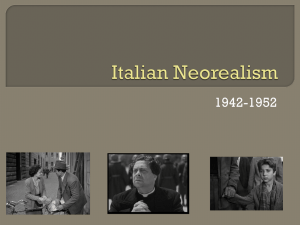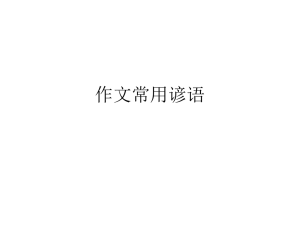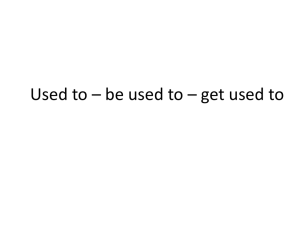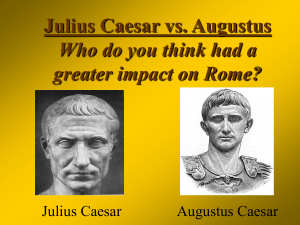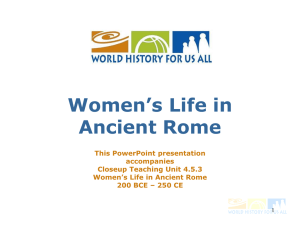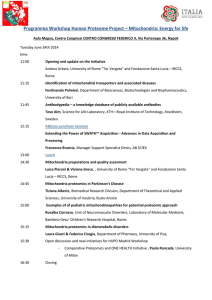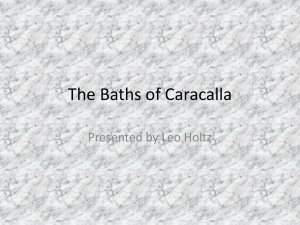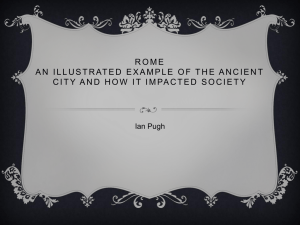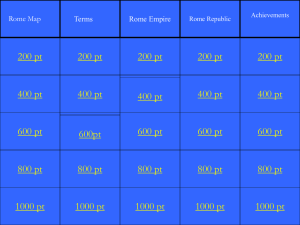City of Rome Class
advertisement
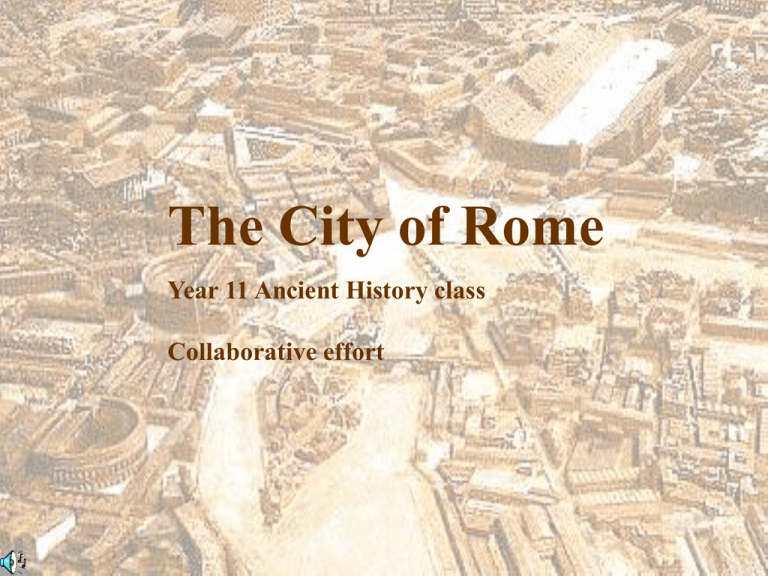
The City of Rome Year 11 Ancient History class Collaborative effort ‘Romanae spatium est urbis et orbis idem” Ovid Ist century AD The extent of the Roman city and the world are the same. 1. At its height Rome’s population reached 1 million people 2. Enclosed within the Aurelian walls ,the city had a radius of 2.2 km. 3. Rome was the first city to use concrete as a building material 4. It was the ability to harness and import a reliable water supply that allowed the city to grow. 5. In 46BC 320,000 people were receiving the free corn dole The Growth of Rome Empire and Urbanization Empire Increased trade and created new markets Population Growth ,and building attracted The landless unemployed Increased Wealth Financed Large Building projects Lands conquered Formed Large estates Called Latifundia Effects of Empire During Conquest, Half the Booty was Paid to Rome Small farms, AbsorbedSubsequent Drift to the city Increase in Migration combined With slavery Led to Massive urban unemployment Conquered lands Paid tax To Rome Immigration “To be deprived of one’s country is intolerable” , you say But come, behold this concourse of men, for whom the houses of immense Rome scarcely suffice; most of this throng are now deprived of their country. From their towns and colonies…they have flocked hither. Some have been brought by ambition, some by the obligation of public office….some seeking a convenient and rich field for luxuria, some by a desire for study, some by the public spectacles…some seing the ample opportunity for displaying energy, by the chance to work: some have presented their beauty for sale, some their eloquenceevery class of person has swarmed into the city that offers prizes for both virtues and vice. Seneca , Ad Helviam Ancient Rome through the eyes of Historians By means of stone pillars, walls of baked brick and party walls of rubble, towers have been raised, and these have been joined together by frequent board floors to produce upper storeys with fine views over the city to the utmost advantage. Therefore walls are raised to a great height through various storeys, and the Roman people has excellent dwellings without hindrance. Vitruvius 2.8.17 Our most scrupulous authorities are agreed that in (78 BC) as fine a house as any in Rome was that of M. Lepidus; but I swear, within 35 years the same house was not among the first hundred. Elder Pliny, H.N. 36.24.110 The plebs urbana used to give their eyes a daily view of country scenes by means of imitation gardens in their windows, before the time when atrocious burglaries in countless numbers compelled them to bar out all the view with shutters. Elder Pliny, H.N. 19.19.59 They build incessantly because of the collapses and fires and repeated sales which go on constantly too. Indeed the repeated sales are intentional collapses, so to speak, since they tear down some buildings and build others in their place to their hearts’ content. Strabo 5.3.7 During the last years of the Republic, the buildings in the forum became the tools of propaganda; they were a form of political persuasion. A limited number of men asserted their power by the monuments they created in this most public place. Sulla, Pompey, Caesar and Augustus each left his mark on the forum as well as elsewhere in Rome Sulla redesigned and reconstructed much of the forum after a destructive fire during the civil war had destroyed the Capitoline Hill. In this construction he used marble. He redesigned and enlarged the Curia Hostilius when he increased the number of senators after his proscription. However, the building that was his greatest monument was the Tabularium or record office. In this design he used an innovation where a whole row of arches superimposed on one another Pompey in his second consulship in 55BC built and dedicated the first stone theatre in Rome in the Campus Martius. In this elaborate games, contests of wild animals and exhibitions of marvels were provided. Within the theatre, Pompey erected statues of the fourteen nations he had subdued. To avoid censure, he constructed a temple of Venus Victrix at the top of the central part, so that the rows of seats might appear to be leading up to the temple. After Caesar’s assassination in this theatre at the foot of Pompey’s statue, Augustus restored the temple but removed the statue of Pompey Julius Caesar, in his building program, took over the most strategic points in the forum. The Speakers’ Rostra was moved from its old site to the centre of the north side of the forum. He demolished the old Senate House and built a new bigger one called the Curia Julia, and on the site of the old Basilica Sempronia he began work on the Basilica Julia. He intended it to house all the law courts. Besides altering the forum, he also created a magnificent one nearby. This was the first in a series of Imperial forums The building program of Augustus ,reflected two of his political goals- he wanted to make a new form of government acceptable by basing it on the restoration of the ancient republican traditions, As well as on the great deeds of the Julian clan. 1. He built a temple to Julius Caesar at the very spot where he was cremated and a statue of the deified Caesar placed in the temple 2. Augustus had the Forum paved with travertine marble, completed the five aisled Basilica Julia and restored after a fire, the Basilica Aemilia. Like Caesar, Augustus built an even larger forum, using brilliant white marble from Carrae. 3. Augustus is quoted as saying “ I found a city of bricks and left Rome a city of Marble. Urban planning The typical Roman city had a rectangular plan with two main streets: the cardo (north-south) and the decumanus (east-west), as well as a grid of smaller streets dividing the town into blocks, and an outer city wall with gates. Older cities, however, such as Rome itself, were founded before regularized city planning, and could therefore consist of a maze of crooked streets. The focal point of the city, whether planned or not, was the forum, the main meeting place and site of the main religious and civic buildings such as the Senate house, records office, and basilica. The Stones of Rome 1. Romans used many different materials to build. 2. The most popular was mud brick strengthened by timbers 3. Hard limestone and volcanic tufa were used for terraces, fortifications, foundations and superstructures 4. Eventually Romans began using travertine because it was stronger. 5. For roof tiles and as a protective covering for wooden parts they used terracotta 6. In the 2nd century BC an unusually strong cement ,that included a volcanic dust called pozzuolana, was used as it was more durable and economical Architectural Influences on Rome 1. During the rule by the Etruscan kings Rome underwent a building boom, made possible by the Etruscan’s knowledge of draining and building 2. .During the Early republic(6th-3rd century BC), buildings increased mostly made of tufa( volcanic limestone) . At the end of the Punic War Rome came into closer contact with the Hellenistic world of Greece, and the increase in urban population and wealth was reflected in the construction of numerous basilicas Innovation in Rome The use of concrete also changed the way many building facades were designed. Weight bearing columns were often replaced with decorative columns and pilasters since the concrete itself carried the building weight. Fragments of bricks showing their trade-marks in the portico of S. Saba. The Romans made wide use of brickwork in a variety of techniques (opus latericium) which help in identifying the period during which a certain building was erected. Archaeologists are also helped by the trade-marks stamped on the bricks by the manufacturers: they had different shapes and they often indicated the name of the manufacturer The following quicktime movie shows a group of undergraduates currently excavating in an area north of the Capitoline Hill How many different types of building materials can you identify? Water Management and Urban Growth- a symbiotic relationship As the needs of both the civic and private establishments within the Roman Republic escalated, the desire for not only a more efficient but also extensive delivery and distribution system of water arose. The result was the construction of a complex system of aqueducts that "evolved on a piecemeal basis over time". The first aqueduct was built in 312 B.C. and over the next five hundred years ten more aqueducts were added to fulfill contemporary and future demands In times of drought, water to homes and industry would be shut off first, public baths, second and public fountains last Observe the growth of the forum and the city of Rome. Make notes about the changes and pace of building from 100BC- 100AD http://cvrlab.org/forum/main.html Resources http://cvrlab.org/forum/main.html excellent interactive map showing the forum, changing over time www.jmiller.demon.co.uk maps of the Roman Empire http://penelope.uchicago.edu/Thayer/E/home.html good general site with images and content www.unicaen.fr/rome/index.php?langue=anglais- excellent geograhical tour of ancient Rome with clickable links and pictures. www.swan.ac.uk/classics/staff/dglectures/augustus/campmart- slide show on campusmartius www.geocities.com/Athens/Forum/1274/ancient-city-by-type.html- very clear clickable map, colour coded www.italybyclick.com/vr/index.html- Modern day virtual tour of ancient sites with clickable pictures www.historylink101.com/ancient_rome_maps.htm- Very navigable site with good links on Circus Maximus, Roman forum, Aquaducts and Building Techniques www.members.aol.com/TeacherNet/AncientRome.html- Table of contents with clickable links. Covers a wide variety of aspects but very valuable for maps of Rome at various stages of its development http://classics.furman.edu/%7erprior/courses/RA/RAU2.html- A University website, probably the most valuable for this topic. A special section on Rome of the Republic it has clickable pictures of almost every major building. http://www.owlnet.rice.edu/~arch343/lecture4.html- Lecture by Dr Richard Ingersoll from Rice University on Urban Planning in Rome. http://sights.seindal.dk/sight/4_Forum_Romanum.html -good clickable photos, content and links www.vroma.org/~bmcmanus/circus.html- excellent site on Circus Maximus, pictures and content Students will research in groups of two or three, one of the following aspect of City Life in the Late Republic 1, the geographical features: rivers, hills, marshes 2. the water system, drains: Cloaca Maxima 3. the Forum Romanum: the Via Sacra (road) 4. the Regia, Temple of Vesta, the Curia, Temple of Saturn, Basilica Aemilia, Basilica Julia, the Rostra, the Tabularium, the Comitium: main features and purposes of the buildings 5. activities in the Forum: politics, administration, religion, courts, theatre, gladiatorial displays, triumphs, speeches, funerals 6. the area of the Campus Martius: buildings: Circus Flaminius, Villa Publica, Altar of Mars; Pompey’s theatre, military training ground 7. the Circus Maximus: main features and uses 1. Students will research the allocated topic , and present it to the class in the format of power point. Each group will be restricted to 3 frames only. 2. Students must include a concise summary of the topic, its construction, history and significance to the life in Rome. 3. Images, maps, labelled diagrams, gif animations are all encouraged. 4. This is a collaborative effort and will be presented by all groups to the rest of the class
